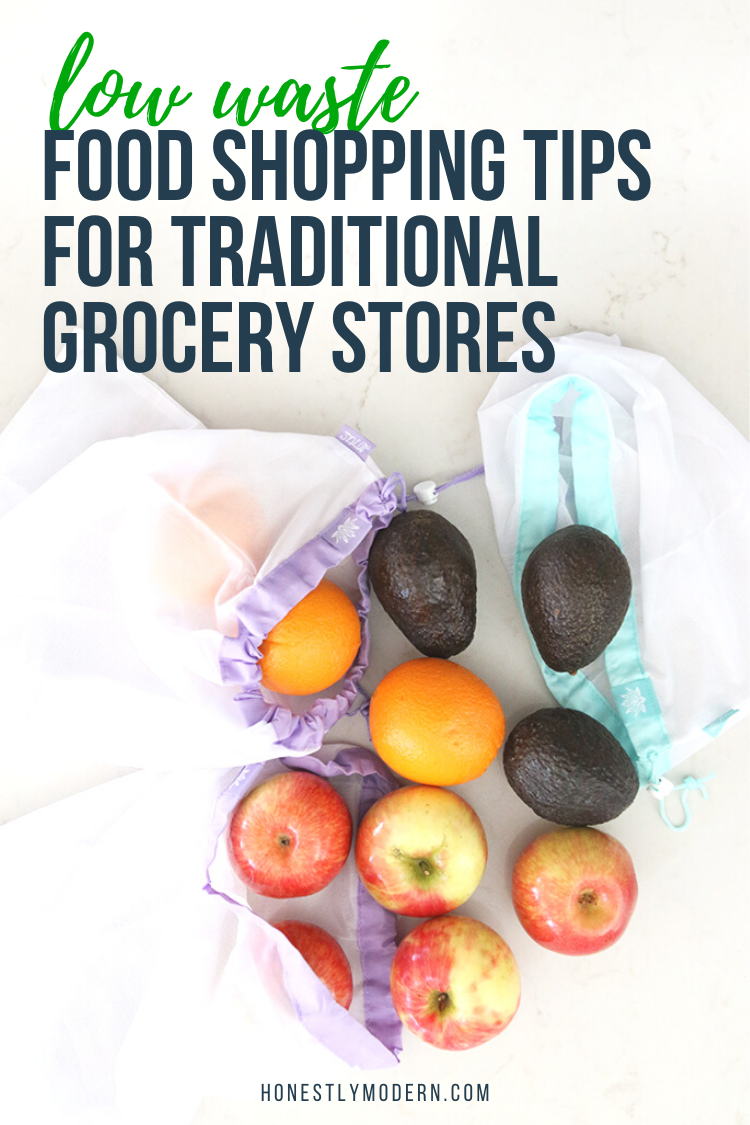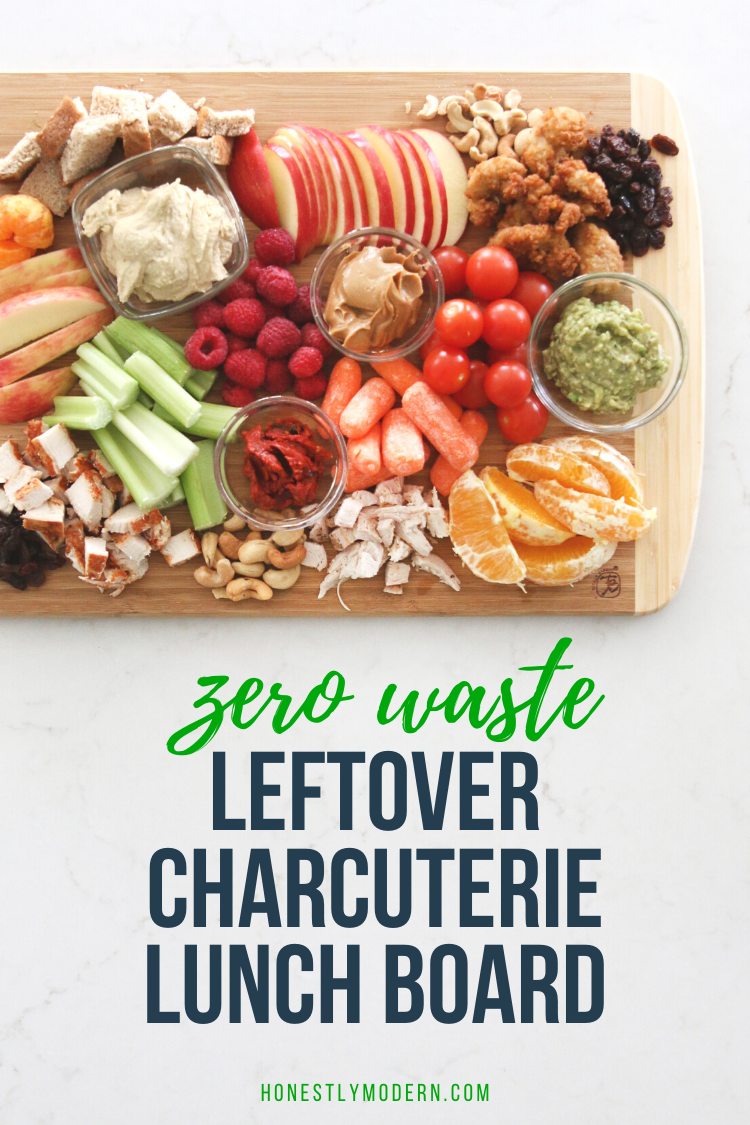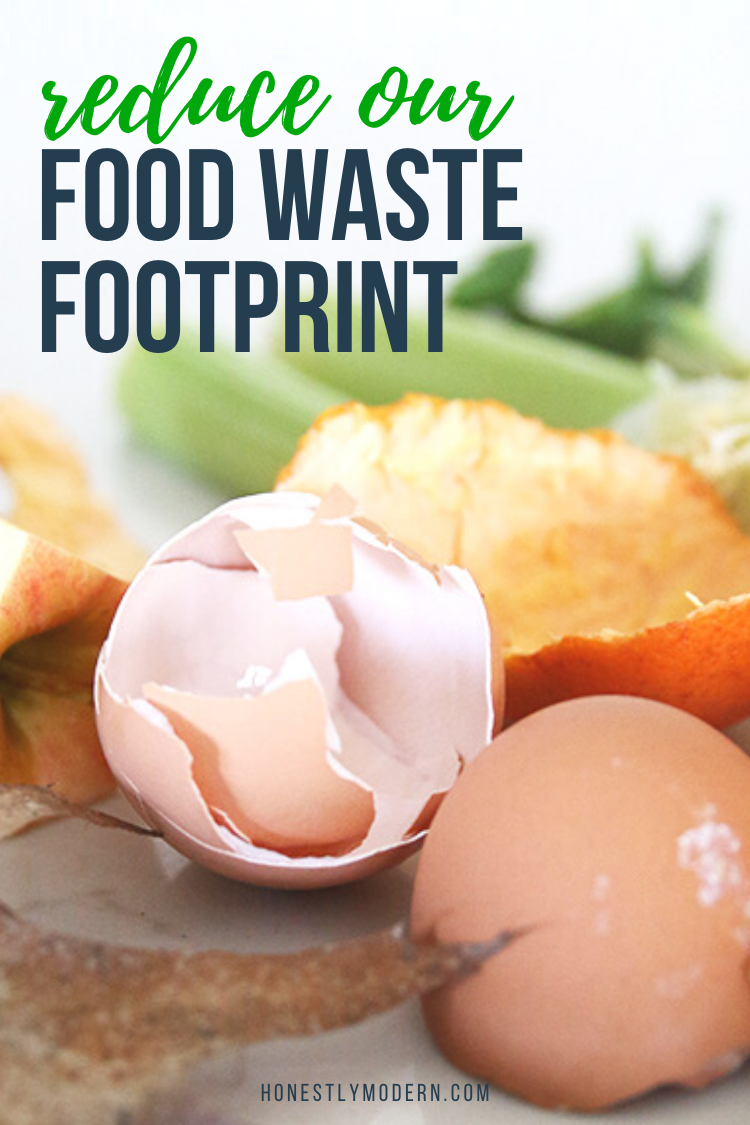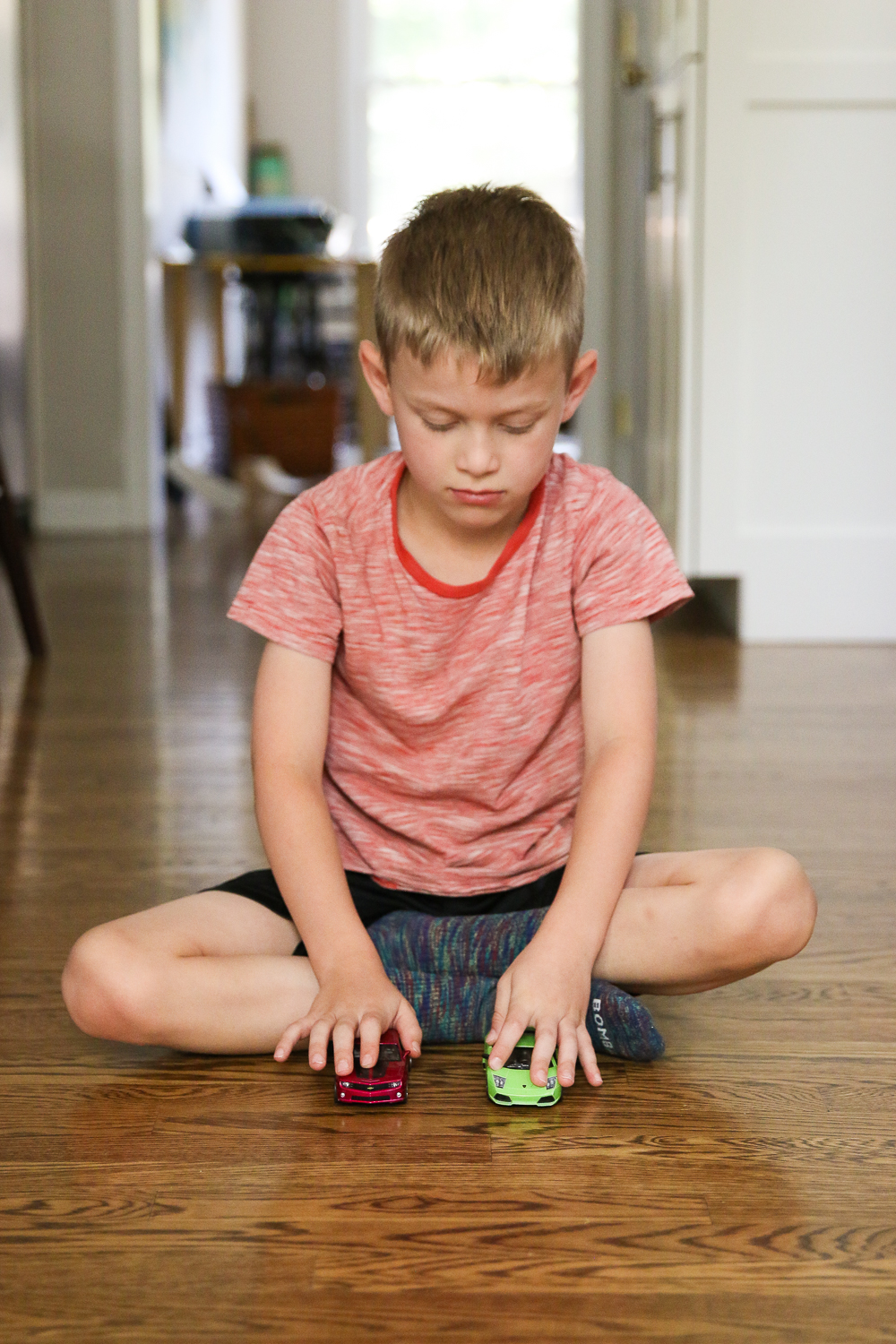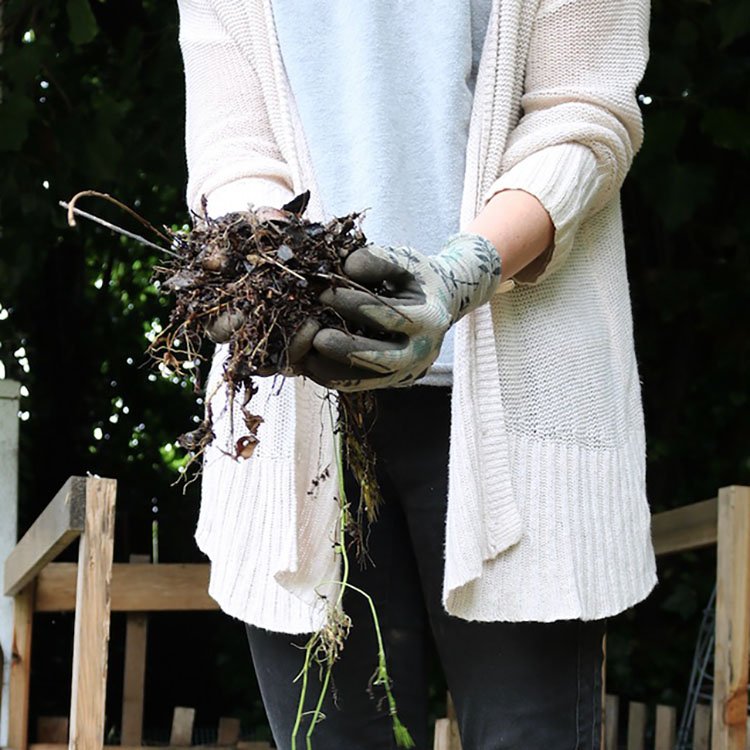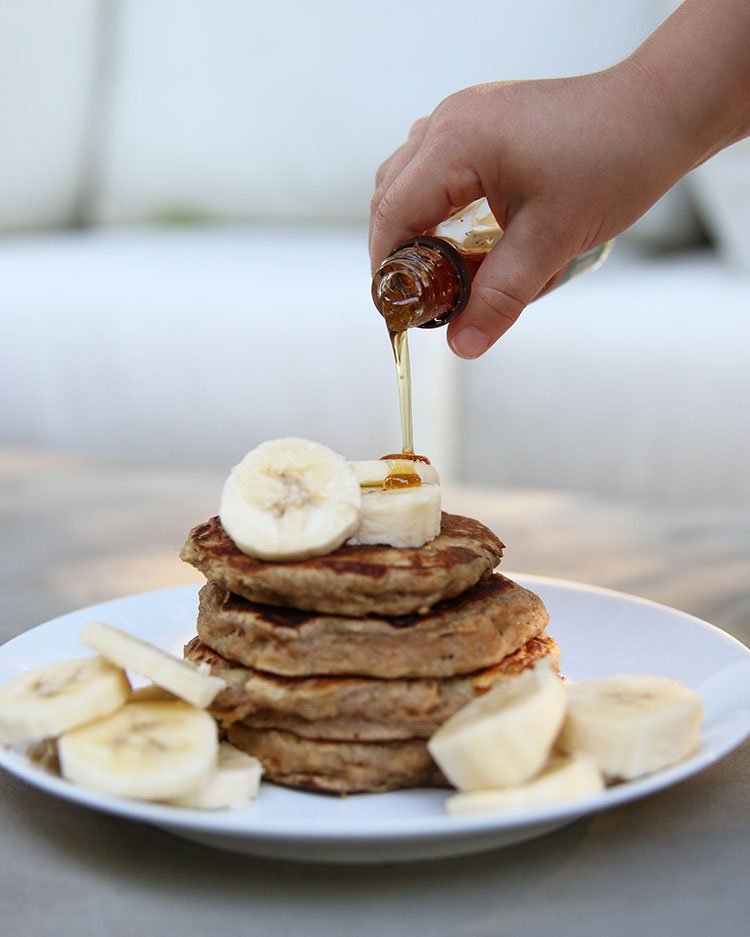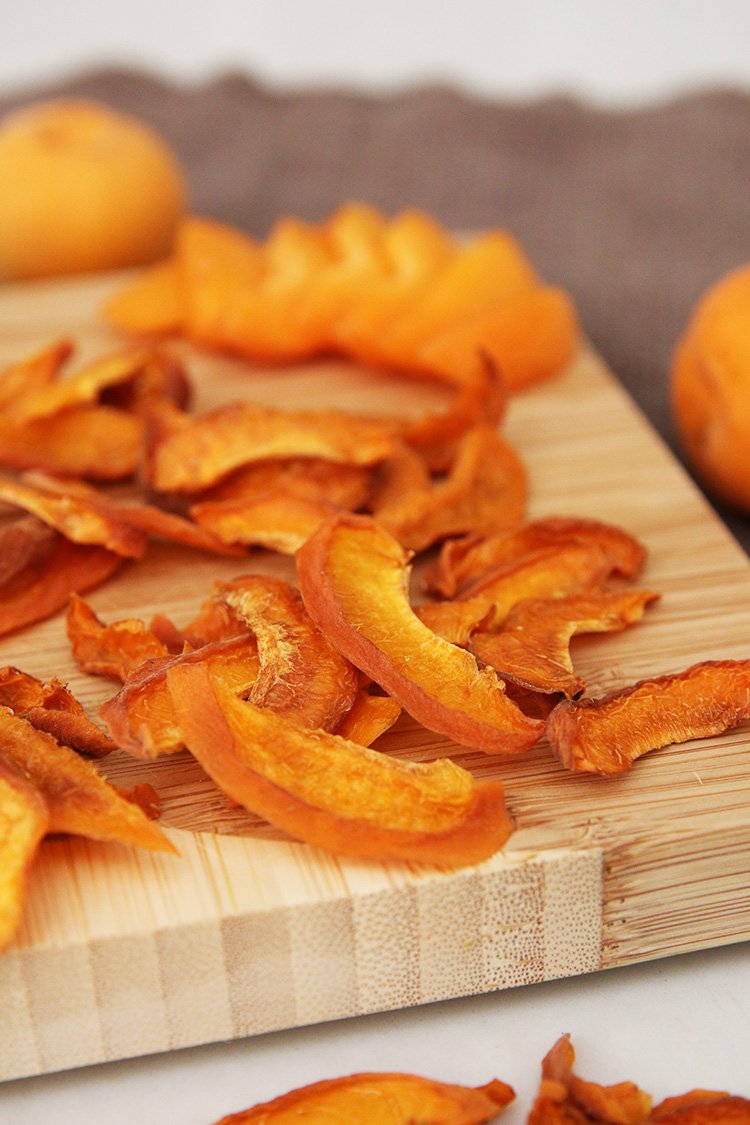Simple Sustainable Food Shopping Tips: Eco-Friendly Grocery Guide
Earth Day is around the corner. Have you considered how to reduce your waste in everyday activities? Check out these four ideas for reducing waste while grocery shopping at traditional grocery stores.
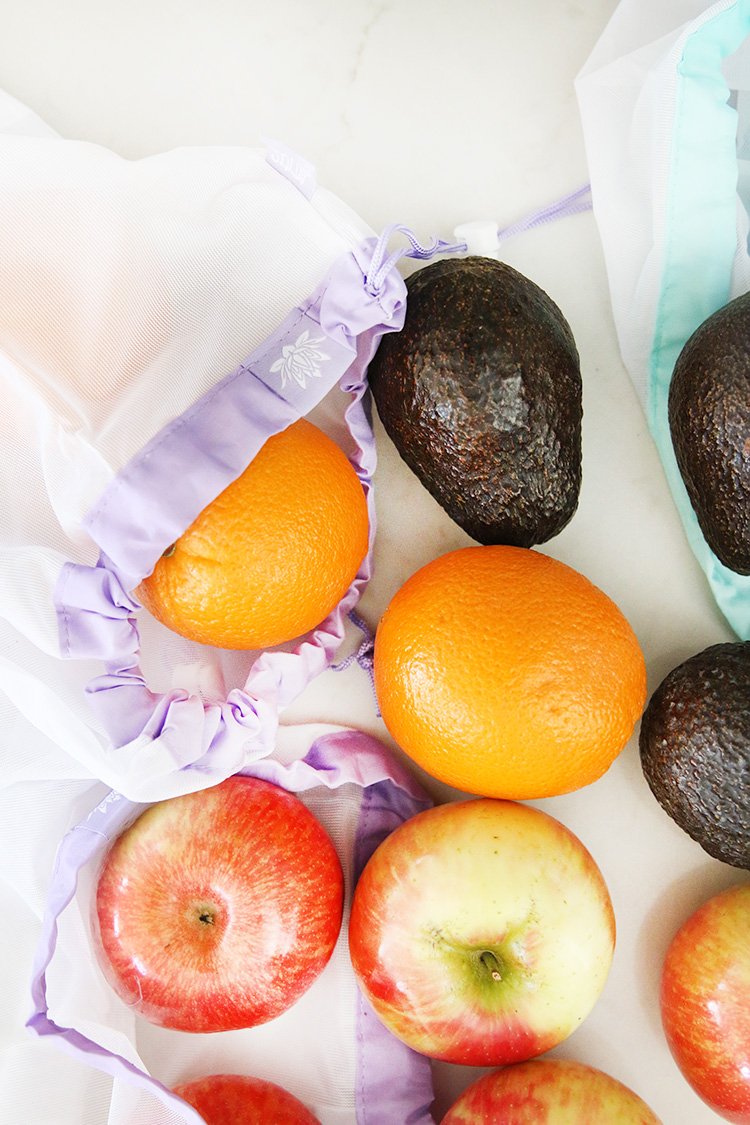
Earth Day is next week. While it might always feel like Earth Day here on the blog, Earth Day around the country and the globe is a great reason to revisit some of our simple habits that might have a harsher impact on our planet then we’d like.
These not-so-earth-friendly habits appear in many forms, but let’s start with one of the simplest and most routine tasks many of us perform at least weekly: grocery shopping.
Environmental impacts of our grocery shopping can run the gamut from truly deplorable to nearly free of harm, depending on the source of our food and its packaging, among other things.
Unfortunately, our food system is pretty broken. Finding food that is grown responsibly and bears a minimal negative impact on the Earth in our communities can be really challenging due to the systemic oppression, waste, harmful production processes, and more, that are inherent in our food supply chain. We need policy changes to fix most of these issues; individual action isn’t a realistic broad solution.
We can bypass some systemic issues by shopping locally through community-supported agriculture (CSA) programs, purchasing from local farmers, ordering from companies like Misfits Market, and purchasing from farmer’s markets. However, not all of us have access to these luxuries, nor is there sufficient supply to meet all our demands through these “better” channels.
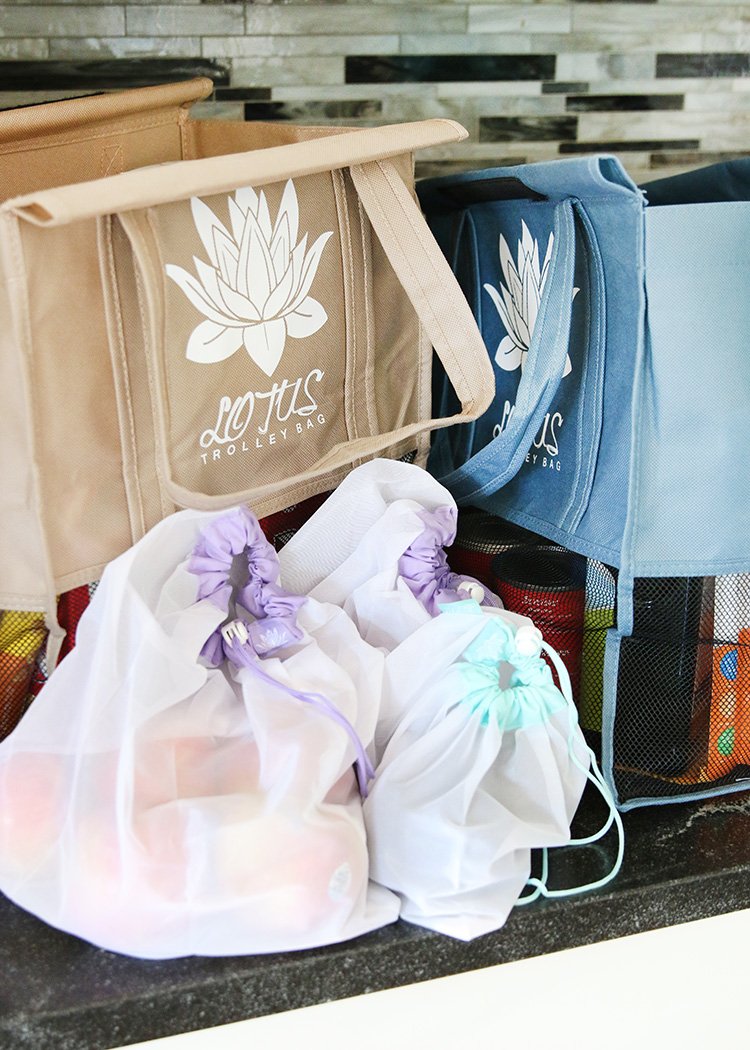
Embarking on a journey to make your grocery shopping more sustainable can seem daunting, but it’s all about making small, impactful changes. You might be wondering how your weekly trip to the store could possibly affect the planet. Well, it turns out that every choice you make, from the type of bags you carry to the produce you select, plays a part in the larger environmental picture. By adopting some straightforward practices, you can significantly reduce your carbon footprint, minimize waste, and support a more sustainable food system.
Think of sustainable grocery shopping as a series of intentional choices that align with eco-friendly values. It’s about considering the lifecycle of the items in your cart – where they come from, how they are packaged, and how they will be disposed of. Opting for local produce is a great start, reducing the greenhouse gas emissions associated with long-distance food transport. Similarly, planning your meals in advance and buying only what you need helps cut down on food waste.
Modern grocery stores are a trove of options and it’s easy to feel overwhelmed by the vast selection. But with a bit of preparation and a focus on sustainability, you can navigate the aisles like a pro. Bringing your own reusable produce bags and avoiding overly packaged goods are just a couple of ways to make a positive impact. With each visit to the store, you’ll become more adept at making choices that are better for the environment and for your health.
Understanding Sustainable Food Shopping
When you shop with sustainability in mind, you’re looking beyond just the products on the shelves. It’s about making choices that have a positive impact on the environment and society.
What Is Sustainable Food Shopping?
Sustainable food shopping means choosing items that are produced, processed, and transported with a lower impact on the environment. It entails selecting products that prioritize:
- Local sourcing: Buying from local farmers and producers to reduce food miles.
- Organic practices: Looking for certifications that ensure foods are grown without harmful pesticides.
- Animal welfare: Opting for products from sources that treat animals humanely.
- Reduced packaging: Choosing items with minimal or eco-friendly packaging to cut down on waste.
Importance of Sustainability in Grocery Shopping
Your grocery choices play a vital role in sustainability. By being mindful of:
- Carbon footprint: The way food is grown can affect greenhouse gas emissions.
- Resource conservation: Understanding the water footprint helps conserve vital resources.
You’re not just shopping; you’re contributing to a more sustainable future with every decision you make.
Planning Your Grocery Trips
Strategic planning for your grocery trips not only saves you time and money but also benefits the environment. By thinking ahead, you can avoid excessive trips and make sustainable choices.
Creating a Sustainable Shopping List
Before you head to the store: begin by checking your pantry and fridge. Make a list of what you actually need to buy. Your shopping list should:
- Prioritize bulk items to reduce packaging waste.
- Include a variety of plant-based proteins, as these have a lower carbon footprint than most animal products.
- Eco-friendly products: look for items with minimal packaging or items packaged in recycled or recyclable materials.
This approach can help minimize impulse buying, leading to less food waste and a lighter environmental footprint.
Seasonal and Local Shopping Guide
When you craft your shopping list, focus on:
- Seasonal fruits and vegetables: They usually have better flavor and lower costs.
- Local products: which support regional farmers and reduce transportation emissions.
| Season | Fruit Example | Vegetable Example |
|---|---|---|
| Spring | Strawberries | Asparagus |
| Summer | Peaches | Bell peppers |
| Fall | Apples | Squash |
| Winter | Pomegranates | Kale |
By following a seasonal and local shopping guide, you’re more likely to enjoy fresher produce and support sustainable agriculture practices.
Choosing the Right Products
When you’re grocery shopping, making sustainable choices means considering both the origins of the food and its packaging. Here’s how to identify products that are better for the planet.
Organic vs. Non-Organic
Organic products are grown without synthetic pesticides or fertilizers. This is better for the soil and local ecosystems. For example, buying organic fruits and vegetables can reduce your environmental footprint. However, remember that just because something is organic doesn’t mean it’s completely sustainable — it could still have traveled a long distance to reach your store.
On the other hand, non-organic products often cost less, but they come with a hidden price: the potential for harmful chemical residues and a larger environmental impact due to intensive farming practices.
Packaging and Product Lifecycles
Check the packaging of products before you buy them. Aim for items with minimal packaging, or those packaged in recycled or recyclable materials. Bulk buying is a good tactic to reduce packaging waste, as is choosing concentrates or refills when available.
Understanding a product’s lifecycle is also key. Products with a longer shelf life tend to be more sustainable, as they reduce the frequency of shopping trips and the potential for food waste. Consider products that have a clear path of recycling or upcycling to ensure they don’t end up in a landfill.
Bulk Buying
When you step into the world of bulk buying, you’re not just saving money; you’re also actively participating in waste reduction.
Benefits of Bulk Purchasing
- Cost Savings: Buying in bulk typically offers a lower cost per unit, which means more bang for your buck. For example, purchasing organic pinto beans from bulk bins can be cheaper than their packaged counterparts.
- Environmental Impact: Your decision to buy in bulk helps minimize packaging waste, which is a step towards a cleaner planet.
Tips for Buying in Bulk
- Start Small: If you’re new to bulk shopping, begin with non-perishable items like rice or lentils that you know you’ll use.
- Bring Your Own Containers: Reduce your plastic usage by bringing reusable jars or cloth bags for your bulk items. Some stores might even give you a discount for doing so.
- Plan Ahead: Know your household’s consumption rates to avoid over-purchasing and ultimately wasting food.
Smart Protein Choices
When it comes to sustainable eating, choosing the right protein sources is crucial. You can make a significant environmental impact by selecting options that have a lower carbon footprint and support eco-friendly production methods.
Plant-Based Protein Options
Legumes: They are a powerhouse of protein and essential nutrients. Incorporating beans, lentils, and chickpeas into your meals not only boosts your protein intake but also contributes to soil health thanks to their nitrogen-fixing properties.
- Chickpeas: Great for hummus or as a salad topping.
- Black beans: Perfect for soups and burritos.
- Lentils: Ideal for hearty stews and dal.
Whole Grains: Whole grains like quinoa and barley not only offer protein but also provide important fiber and vitamins. Quinoa, for instance, is a complete protein, meaning it contains all nine essential amino acids.
- Quinoa: Versatile for bowls and side dishes.
- Barley: A robust addition to soups and risottos.
Nuts and Seeds: Nuts and seeds are perfect for snacking and are a great addition to various dishes. They offer a healthy dose of protein and beneficial fats.
- Almonds, pistachios, and pumpkin seeds can be easily incorporated into your diet for a plant-based protein boost.
Sustainable Meat and Seafood Selection
Meat: When you choose meat, look for labels like “grass-fed,” “organic,” or “free-range.” These often indicate more sustainable farming practices.
- Chicken: Generally has a lower environmental impact than red meats.
- Grass-fed beef: Comes from cows that graze on grass, resulting in meat that’s more sustainable and higher in certain nutrients.
Seafood: Sustainable seafood is about selecting species that are abundantly available and farmed or caught in eco-friendly ways.
- MSC-Certified: Look for the Marine Stewardship Council’s blue label on wild-caught fish.
- Farmed Shellfish: Mussels, clams, and oysters can be a good choice as they clean the water in which they are farmed and often do not require feed.
Energy-Efficient Food Storage
When you’re looking to reduce your carbon footprint, the way you store your food can make a significant impact. Let’s zero in on keeping your groceries fresh while being kind to the planet.
Proper Food Storage Techniques
- Use Reusable Containers: Switching to reusable silicone bags can keep your food fresh without single-use plastics. They’re a great investment for both your kitchen and the environment.
- Optimize Your Fridge: Arrange your food so it cools evenly, and set your refrigerator temperature correctly to prevent overcooling.
Energy-Saving Kitchen Appliances
- Upgrade to Efficient Models: If you’re in the market for a new fridge, look for energy-efficient models that have a good Energy Star rating.
- Maintain Your Appliances: Regularly defrosting your freezer and cleaning the back coils of your fridge improve efficiency and extend the appliance’s life.
Eco-Friendly Grocery Transportation
Choosing eco-friendly transportation options for grocery shopping can significantly reduce your carbon footprint. Let’s dive into how you can make your trip to the store greener.
Using Reusable Bags
Reusable bags are your best friends when it comes to sustainable grocery shopping. Not only do they cut down on plastic waste, but they’re sturdier and can handle more groceries. Remember to bring them along every time you head out—you’ll be making a small change with a big impact.
Alternative Transportation Methods
Consider your ride to the store. Can you take a bike or use public transport? Maybe a carpool with a neighbor? Every time you opt for a non-motorized transportation method or share a ride, you’re choosing to reduce emissions. This not only helps the planet but often saves you money on gas and parking.
Reusing Paper and Plastic Grocery Bags
If you forget your reusable bags, it’s not the end of the world. Make sure to save those plastic and paper bags for future use. Store them in your car or by the door so you’ll grab them on your next trip. Reusing them as much as possible before recycling helps minimize waste.
Supporting Sustainable Food Sources
When you shop for groceries, your choices can have a big impact on the environment. By choosing to shop at farmers’ markets and participating in CSA programs, you’re directly supporting sustainable practices.
Farmers’ Markets and Co-ops
Farmers’ markets are a treasure trove of fresh, seasonal produce directly from local growers. By shopping here, you cut down on the transportation emissions typically associated with grocery store goods. Plus, you get your hands on some of the freshest fruits and veggies around, often organic and without unnecessary packaging. Remember to bring your reusable bags for an even greener shopping trip.
Co-ops are community-oriented marketplaces that prioritize local and sustainable farming. By becoming a member or buying from co-ops, you’re voting for sustainable practices with your dollar. They often source from many small farmers, which supports a more diverse agricultural landscape.
Community Supported Agriculture (CSA)
Joining a CSA program connects you directly with a local farm. By purchasing a share, you receive regular boxes of produce throughout the farming season. This model guarantees farmers upfront, stable income and reduces food waste by growing only what’s needed. Plus, there’s nothing quite like the surprise of unboxing your share to discover new vegetables you might not have tried otherwise. Get involved with your own local CSA and embrace the benefits it brings to you and your community. For more information, check out sustainable grocery shopping tips.
Green Kitchen Practices
Making your kitchen more sustainable can be both fun and beneficial for the environment. Focus on these key areas: managing waste efficiently and adjusting your cooking habits for better energy conservation.
Composting Kitchen Scraps
You might be surprised at how much of your kitchen waste can skip the trash bin and go straight to composting. Things like fruit peels, vegetable scraps, coffee grounds, and eggshells are gold for composting. By composting your kitchen scraps, you reduce landfill waste and create a rich soil additive for your garden or houseplants.
Eco-Friendly Cooking Habits
Adopting more energy-efficient cooking methods can make a big impact on your energy bill and carbon footprint. For instance, always remember to put a lid on pots when boiling water; this keeps the heat in, making your stove work less and speeding up the cooking time. Also, use appliances like pressure cookers and microwaves when possible, as they are often more energy-efficient than ovens or stovetops.
Frequently Asked Questions
Embracing sustainable shopping habits can make a significant difference in reducing your environmental footprint. Below are some practical tips to help guide your grocery shopping choices.
What are the best practices for reducing waste while grocery shopping?
By choosing products with minimal packaging, buying in bulk, and bringing your own reusable bags, you can significantly cut down on the waste you generate. Focus on buying only the quantity you need to avoid food spoilage.
Can you recommend tips for choosing eco-friendly packaging at the supermarket?
Opt for products packaged in materials that are biodegradable or recyclable such as paper or glass. If plastic can’t be avoided, look for items packaged in recycled or recyclable plastics.
How can I support local agriculture when I do my food shopping?
Purchase fruits, vegetables, and other items from local farmers’ markets or look for signage in your supermarket that indicates local sourcing. This supports local farmers and reduces the carbon emissions associated with transporting goods over long distances.
In what ways can I minimize food miles during my grocery runs?
Plan your meals around seasonal produce and check labels to choose foods that are grown or produced nearby. By limiting the distance food travels from farm to table, you’re reducing greenhouse gas emissions.
Could you suggest strategies for avoiding single-use plastics at the grocery store?
Bring reusable cloth or mesh produce bags and containers for bulk items. Be on the lookout for products with alternative or no packaging, and if available, refill your own containers at stores that offer bulk liquid stations.
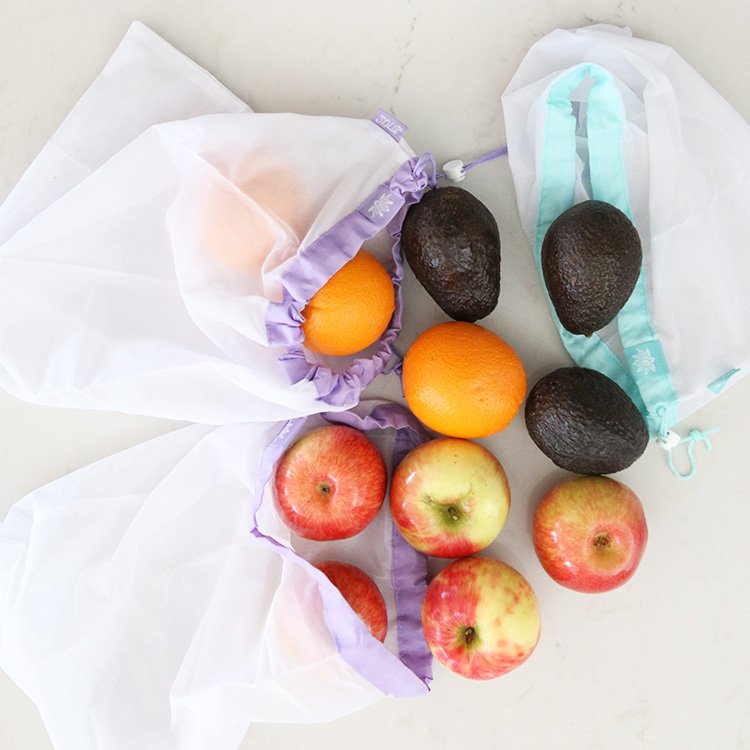
Four Simple Tips for Low Waste Grocery Shopping
All that aside, today I want to focus on a few simple habit modifications we can make right now while grocery shopping at traditional supermarket chains to reduce our negative impact on the planet Earth.
Bring You Own Checkout & Produce Bags
I know. I know. Everyone already knows this right?! It’s on every zero or low waste grocery shopping hit list. But here’s the thing (or two things really).
First, most people still don’t bring their own checkout bags?! Why oh why?! Once in a while I forget to bring my bags. I get it. But even if we assume everyone forgets on occasion, most people would still have their own bags. But they don’t!
Bringing your own checkout bags isn’t just about helping the planet and our communities. It’s about functionality. Reusable bags are sturdier, steadier, and hold more so you have fewer bags to carry. They’re so much better (even the free ones given out at various events around town).
Also, I cringe when I see a cart full of little plastic bags to carry each type of produce. In many cases, produce just doesn’t need a bag. Doesn’t everything get washed at home? A few things, like broccoli or brussel sprouts, are much cleaner and easier to manage in a bag, but we shouldn’t have a cart full of little plastic bags that are ultimately headed straight to the trash or recycling bin once home.
I’ve tried a variety of produce bags from different brands. I’ve also made my own drawstring bags and used other types of bags as produce bags. After all my test runs, I’m sold on mesh produce bags with tight closures. They are light and easy to use, and the produce doesn’t fall out while I’m shopping. They have tare weights on the tags or bags. They are washable but breathable. Despite trying to make the most of what I have already, I’m convinced that investing in real produce bags is worthwhile if it’s in your budget.
I started using these Lotus produce bags and definitely recommend these. They are my favorite brand and also have a reasonable price relative to competitive brands.
If you’re feeling extra fancy, Lotus also makes trolley bags that hang in standard grocery carts and can be used as regular reusable bags. They are pretty neat. They have extra pockets for fragile things like wine and eggs. Additionally, one of the bags is a cooler bag so it will help keep fridge and freezer foods cold during transport.
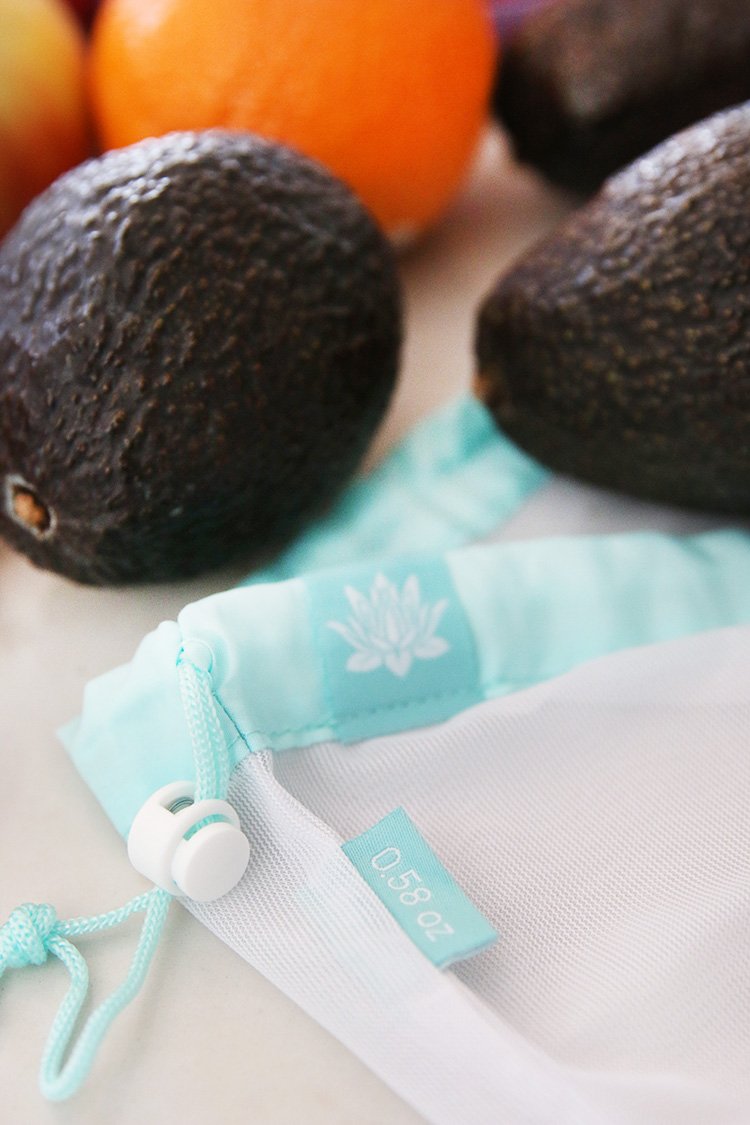
Tare Labels on BYO Jars, Bags and Containers
The tare of a bag or container is the weight of the item when it’s empty. In other words, it is the weight that should be subtracted from the jar or bag when filled to determine the true amount of product being purchased in that container.
Some containers and bags, like the Lotus produce bags, include the tare on the manufactured product. However if you’re using a reused glass jar, like one of these re-purposed glass jars in our cabinets, you’ll need to measure the tare of the jars or container on your own.
For light bags, I do not measure the tare. I may be paying slightly more than necessary, but the bags are so light that the difference is very tiny. The weight of a glass jar however, is much more significant. In this case, I prefer to tare the jar one time and adhere a label with the tare amount to the jar so I don’t have to measure it each time.
I ordered a set of Mabel’s Labels that say “tare” on them, and use these labels as needed. For each jar, I use a Sharpie to write the weight on the jar on the label. We have used Mabel’s Labels on the boys lunch boxes and other school supplies for years. They are awesome because they stick so well and don’t come off in the dishwasher.
Choose Packaging That is Reusable, Recyclable or Compostable
The simplest habit change that involves no advanced preparation might be simply paying attention to the packaging of the products you buy.
When making a purchase, consider if you can reuse the packaging. You might opt to buy something in a nice glass jar instead of a flimsy plastic alternative if you can use the glass jar for something else down the road. For example, we buy Rao’s pasta sauce, and I save all the jars. They are about the size of a mason jar, and I can easily clean and reuse the jars.
Additionally, opt for cardboard or paperboard packaging instead of plastics when possible. For example, pass up the eggs in plastic cartons and opt for the eggs in paperboard cartons that can be recycled or composted. Find all the details about composting at home in this guide.
Sugar and flour often come in plastic or paper bags. Choose the paper bags and recycle or compost the packaging instead of choosing more plastic to send to the landfill. I’ve shared a whole bunch of other tips for zero waste and low waste baking that include these tips about packaging and many more.

Head to the Bulk or Unpackaged Sections
Some grocery stores have fantastic bulk sections full of dry goods, baking ingredients, snack foods, and more. If your local grocery store has bulk sections, take a look around and see if you can buy ingredients and items from those sections instead of the shelves of pre-packaged good.
Many grocery stores, however, do not necessarily have Instagram-worthy bulk bins. But they do have more bulk or unpackaged food then we might initially realize.
Consider the produce section. Produce is not a quintessential bulk product by definition, but many fruits and vegetables come without packaging. I love the Lotus produce bags because I can grab all of my fruits and veggies that do not come in plastic packaging without pulling loads of plastic bags off of the spindles.
We can also find bulk products on the shelves. To the extent you’re in search of food that comes in different size packages, skip the individual servings and opt for the largest container you can find that you will use before it goes bad. The products still have packaging but they require less packaging (and significantly so relative to items that come in individual servings).
Many meat, fish, and deli counters also allow you to choose just the right amount of food to meet your needs. If you’re feeling ambitious you may even be able to use your own containers at these counters. Some stores are more accommodating than others.
Lastly, some stores have salad bar sections, mochi freezers, and bakery sections that all allow you to select exactly what you want without packaging. If your stores have these options, consider if they meet your needs and fit into your budget.
For many of us, true zero-waste grocery shopping isn’t realistic. There are too many systematic challenges to overcome that make it time and cost-prohibitive. However, we can still significantly reduce the waste we create (especially with respect to single-use waste) by making a few more conscious or thoughtful choices about how we grocery shop.
Do you have any great zero or low waste grocery shopping suggestions for traditional grocery stores? I’d love to hear them in the comments!
If you’re looking to reduce waste while grocery shopping, you might also like these tips to reduce food waste at home. Check out all the tips including a two page printable of ideas to try at home. I’ve also shared all about our zero waste leftover lunch charcuterie board. It was one of the best family lunches we’ve had in a while!

